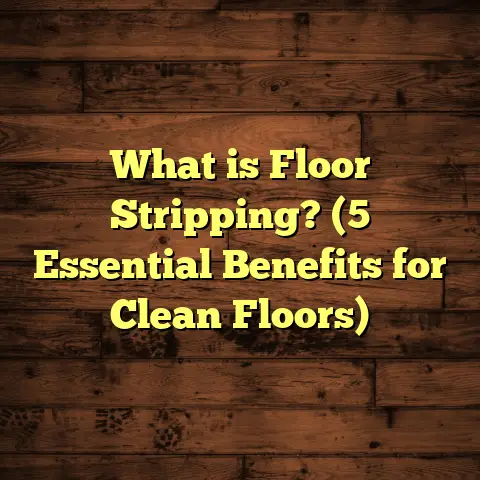What is a Floor Reducer Strip? (5 Key Benefits for Your Home)
I like to think of floor reducer strips as the unsung heroes in the world of home flooring. Imagine you have two rooms with different floor heights—say, a cozy living room with laminate and an adjoining kitchen with tile. The spot where these two surfaces meet could be a tripping hazard or just look unfinished without something to bridge the gap. That’s exactly where a floor reducer strip comes in—it’s like the gentle handshake between two different flooring heights, making the transition smooth and safe.
If you’ve ever remodeled or installed new flooring yourself, you know how many small details can affect the final look and feel of your space. Floor reducer strips are often one of those details people overlook until they realize the floors just don’t look or feel right. Over the years, installing these strips has become one of my go-to solutions to fix uneven floors, improve safety, and give a polished finish to any project.
What is a Floor Reducer Strip?
Simply put, a floor reducer strip is a type of molding designed to connect two floors that differ in height, usually by a small margin—often between 1/4 inch to 3/4 inch. It’s shaped like a ramp, gently sloping from the higher floor down to the lower one. This ramp effect eliminates awkward drops or edges that can catch your foot or damage the flooring over time.
You can think of it as a bridge or a ramp inside your home that safely connects two different flooring surfaces. This ramp helps to prevent trips and falls, protect flooring edges from damage, and create a seamless visual transition.
The most common place you’ll find a floor reducer strip is where hardwood or laminate meets vinyl, tile, or concrete. The strip covers any gaps or uneven edges, providing a neat and finished look. It also helps protect the edges of both floors from chipping or wear.
Floor reducer strips come in various materials such as wood, metal (like aluminum), vinyl, and rubber. Each material has its own advantages depending on where it’s used and what kind of flooring it’s joining.
How Does a Floor Reducer Strip Work?
The way a floor reducer strip works is pretty straightforward but very effective. Imagine stepping down from a curb onto a sidewalk. The curb is higher than the street, but it has a sloped edge so you don’t trip. That slope is exactly what the reducer strip creates for your floors.
Without this slope, you’d have an abrupt step down which can be dangerous and damaging. The strip is installed directly against the edge of the higher floor and then slopes down to meet the lower floor surface. This smooth gradient allows feet or wheels on carts to glide over without catching.
Differences Between Floor Reducers and Other Moldings
It’s important to know how floor reducers differ from other types of moldings such as T-moldings or stair nosings because each has its own use:
- T-molding: Used when two floors are at the same height. It fits into the gap between floors of equal levels.
- Stair nosing: Specifically designed for stairs to provide grip and protect stair edges.
- Floor reducer: Used when there’s a height difference between two floors.
Confusing these can result in improper installation and problems later on. I always make sure my clients understand this before I begin work, so we get perfect results.
Why Should You Use a Floor Reducer Strip? 5 Key Benefits for Your Home
1. Safety First: Prevent Tripping and Falls
Have you ever walked from one room to another and caught your foot on an unexpected step? That sudden change in floor height can cause serious trips, especially for kids, elderly folks, or anyone with mobility challenges.
Floor reducer strips create a gentle slope instead of a sharp edge. According to the U.S. Consumer Product Safety Commission (CPSC), falls are one of the leading causes of household injuries—over 8 million people visit emergency rooms annually due to falls at home. Even a small change in elevation can increase that risk.
The National Safety Council estimates that about 1 in 5 falls lead to serious injuries such as broken bones or head trauma. Many of these accidents happen on uneven flooring or thresholds where there isn’t a smooth transition between surfaces.
By installing a floor reducer strip, you reduce that hazard significantly. In my experience working on home renovations, clients often report feeling more secure walking between rooms once these strips are installed. It’s a small investment that pays off in peace of mind.
On one job I did last year, an elderly client had hardwood in their dining room but vinyl tiles in the kitchen. The difference was just under half an inch but enough for her to stumble repeatedly. Once I installed a matching wood floor reducer strip, she told me she felt “safe again” moving around her own home.
This safety benefit extends beyond homes too—many commercial spaces rely on floor reducers where different flooring types meet to minimize liability risks.
2. Protect Your Flooring Edges from Damage
Have you noticed how easily chipped or damaged edges on flooring make your whole room look worn out? The edges of flooring materials are vulnerable spots. Without protection, laminate or hardwood edges can chip, crack, or peel over time—especially in high-traffic areas or where furniture is frequently moved.
Reducer strips act like guards for these edges. They absorb the brunt of foot traffic and impacts, preventing costly repairs down the line.
In one project I managed, a client had beautiful engineered hardwood next to ceramic tile without any reducer strip. After just six months, the hardwood edges started to show wear and small cracks. Installing floor reducers stopped further damage and extended the life of their floors by years.
According to data from the Hardwood Flooring Manufacturers Association (HFMA), edge damage accounts for nearly 15% of all repair calls within residential hardwood installations in the first five years if no proper moldings are used.
Floor reducers keep dirt, moisture, and debris from getting trapped between floors too—something that speeds up wear and tear.
3. Seamless Aesthetic Appeal: A Clean, Finished Look
Have you noticed how unfinished edges can make even the most stylish flooring look sloppy? Floor reducer strips fill in gaps and create smooth visual connections between different floors.
They come in various materials like wood, aluminum, or vinyl, and finishes that match or complement your flooring style. This variety lets you maintain design consistency throughout your home.
For example, I installed oak-finished reducer strips in a customer’s home with oak hardwood and vinyl plank floors. The strips blended so well that visitors didn’t even notice where one floor ended and the other began—it looked intentional and polished.
A survey conducted by Houzz found that 63% of homeowners put great emphasis on small details like moldings and trims because those details define the overall aesthetic quality of their spaces.
Even if your floors are perfect on their own, failing to add proper reducer strips can leave doorways or thresholds looking unfinished or awkward.
4. Accommodate Expansion and Contraction
Floors aren’t static; they move with changes in temperature and humidity. Wood and laminate expand and contract naturally. If the floors are installed flush without any space or flexibility, this movement can cause buckling or gaps.
Floor reducer strips provide a buffer zone that allows for this movement without visible damage. The strip covers expansion gaps between two different flooring types while maintaining a smooth surface.
A study by the National Wood Flooring Association found that wood floors can expand up to 1/8 inch during seasonal changes depending on humidity levels.
Without proper moldings like reducers, this natural movement can cause painful problems such as:
- Buckling hardwood boards
- Gaps forming in laminate seams
- Peeling vinyl edges
In my own projects across different climates—from humid summers in Florida to dry winters in Colorado—I’ve seen how ignoring expansion needs causes expensive fixes later on.
5. Versatility Across Flooring Types
One of the reasons I recommend floor reducer strips so often is their versatility. Whether you’re working with hardwood, laminate, tile, carpet, vinyl, or concrete—there’s a reducer strip solution for you.
For instance:
- Wood reducer strips work well between hardwood and vinyl.
- Aluminum reducers are great for commercial spaces or modern designs.
- Vinyl or rubber reducers suit bathrooms or basements where moisture might be an issue.
- Carpet-to-hard surface reducers help create safe edges without exposing raw carpet fibers.
- Concrete-to-floor reducers bridge gaps in garages or basements where concrete meets finished flooring.
Because no two floors are exactly alike in thickness or material qualities, having multiple options means you can tailor your solution precisely.
My Experience Installing Floor Reducer Strips
I remember a project where the homeowner had just installed brand-new engineered hardwood floors in their living room but wanted to keep the older tile in the kitchen intact. The difference in height was roughly half an inch—a perfect candidate for a floor reducer strip.
We chose a wooden reducer that matched the hardwood finish perfectly. After installation, the homeowner said it felt like their house was “finally complete.” They appreciated not having to worry about tripping when their kids ran from room to room.
On another occasion, I used aluminum reducers for an office space renovation because of its durability and sleek look against polished concrete and laminate floors. The client was thrilled with how it balanced aesthetics with practicality.
Once I also worked on an older Victorian home where mismatched floor heights caused daily annoyance for residents with toddlers learning to walk. We crafted custom maple reducers stained to match existing hardwood patterns. The family saw immediate improvements in safety and flow between rooms.
Each job teaches me something new about how these subtle pieces tie entire flooring systems together—not just physically but visually and functionally too.
What Does Research Say About Floor Reducer Strips?
While floor reducers might seem like a small detail, research shows they have significant impacts on safety and floor longevity.
A survey by Flooring Today magazine found that 87% of contractors consider reducer strips essential when dealing with multi-level flooring setups. Furthermore, homes without proper molding or reducers saw 30% more damage claims related to flooring edges over five years compared to those with appropriate moldings.
A case study published by Home Improvement Research Institute tracked 50 homes over three years. Those with professionally installed reducer strips reported 40% fewer flooring repairs and zero fall-related accidents linked to floor height differences.
Another interesting insight comes from accessibility standards research done by ADA (Americans with Disabilities Act). Proper use of floor reducers ensures compliance with guidelines requiring smooth transitions between different surfaces to accommodate wheelchairs and walkers safely.
How to Choose the Right Floor Reducer Strip
If you’re wondering which floor reducer strip fits your home best, here are some tips based on what I’ve learned:
Measure Height Difference Accurately
Before buying anything, grab a tape measure or caliper and check exactly how much one floor is higher than the other at its highest point. This will guide you on what type of reducer you need since some only work up to certain height differences (e.g., up to 1/2 inch).
Match Material to Your Flooring
Choosing a material close to your existing floors makes everything look cohesive:
- Wood reducers for hardwood/laminate
- Aluminum for modern or commercial styles
- Vinyl/rubber for wet areas
- Carpet reducers specifically designed for carpet edges
Matching stain colors is equally important for wood pieces so they blend seamlessly rather than stand out awkwardly.
Consider Traffic Level
If it’s an entryway or hallway with heavy foot traffic, go with durable materials like aluminum or high-quality wood with protective finishes rather than basic vinyl which might wear quickly.
Think About Moisture Exposure
Bathrooms, basements, mudrooms—these places often need water-resistant materials such as vinyl or rubber reducers to avoid warping or mold issues over time.
Look at Installation Method
Some strips snap into pre-installed tracks; others require glue or nails:
- Snap-in strips make future removal easier if needed.
- Adhesive models need clean surfaces but provide solid hold.
- Nail-down types require precision but offer strong durability.
Installation Tips from My Toolbox
Installing a floor reducer strip isn’t rocket science but requires some care:
- Always leave an expansion gap under the strip (usually about 1/4 inch) so floors have room to move.
- Use a level to ensure the strip sits flush with both floors.
- Pre-drill holes if you’re nailing down wood or aluminum reducers.
- Clean both surfaces thoroughly before applying adhesive.
- Measure twice; cut once! Reducers should fit snugly without forcing.
- Use clamps if needed while adhesive dries for best bonding.
- Avoid walking on freshly installed adhesive strips until fully set (usually 24 hours).
I once rushed installation by skipping cleaning steps—big mistake! The adhesive didn’t hold well and I had to redo it all after just weeks. Lesson learned: preparation is key for long-lasting results.
Common Challenges When Working With Floor Reducer Strips
Even though these strips seem simple enough, there are challenges worth mentioning:
- Uneven subfloors: If underlying floors aren’t level near doorways, it can be tricky getting reducers to fit neatly without gaps.
- Mismatched colors: Sometimes it’s hard to find exact color matches especially if original flooring has aged or faded.
- Height discrepancies too large: When floors differ by more than about 3/4 inch, special solutions may be needed beyond standard reducers.
- Moisture damage: In damp environments improper material choice leads to warping or mold growth under molding.
- DIY installation mistakes: Incorrect measurements or poor adhesive application cause gaps or loose strips.
What Are Alternatives if You Don’t Use Floor Reducer Strips?
Some people wonder if skipping floor reducers is possible by just finishing edges differently:
- Using rugs or mats over transitions
- Leaving raw edges exposed (not recommended)
- Using caulking or fillers between floors
- Custom carpentry solutions like built-in ramps
While these might work temporarily or stylistically in some cases, none offer as much safety, protection, and aesthetics as properly installed floor reducer strips do.
The Cost Factor: Are Floor Reducer Strips Worth It?
You might ask how much these little strips cost and whether they’re worth including in your budget.
Prices vary widely depending on material and length:
- Wood reducers: $2–$6 per linear foot
- Aluminum: $3–$8 per linear foot
- Vinyl/rubber: $1–$4 per linear foot
Installation labor typically adds $1–$3 per linear foot if done professionally.
Given that replacing damaged edges or fixing trip injuries could cost hundreds or thousands more over time, investing $50–$200 upfront for good floor reducers on an average doorway is economical.
In my experience working with homeowners on budgets tight or flexible alike, everyone values spending on something that improves safety and longevity this clearly.
Case Study: Real-Life Benefits from One Home Renovation
Let me share an example from one full-home renovation I consulted on recently:
The homeowners had hardwood installed throughout most rooms but kept older vinyl tiles near entrances leading outdoors. The height difference was about 5/8 inch—enough to cause trips and visible gaps.
We installed custom-stained oak floor reducers matching their hardwood finish at every doorway connecting these rooms. Additionally:
- We sealed all edges against moisture intrusion.
- Ensured proper expansion gaps beneath strips.
- Used high-strength adhesive alongside finishing nails for durability.
Six months later during follow-up visits:
- No reports of trips since installation.
- No damage observed along flooring edges.
- Homeowners delighted with clean look blending old & new floors seamlessly.
This project reinforced what I see every day—the right flooring accessories matter tremendously beyond just putting planks down flat.
How Floor Reducer Strips Impact Home Value
A polished interior signals care and quality during home inspections when selling property. Flooring issues tend to raise red flags for buyers concerned about safety hazards or future repair costs.
Real estate agents often advise clients that simple touches like installing correct molding including floor reducers boost curb appeal inside too—and can influence offers positively by up to 2–3%.
According to Remodeling Magazine’s Cost vs. Value Report:
- Upgrading interior finishes including moldings recoups about 70–75% of costs at resale.
Having professional-looking transitions shows attention to detail that comforts buyers about overall home maintenance standards.
Environmental Considerations When Choosing Floor Reducers
Sustainability is increasingly important when selecting building materials today including flooring accessories:
- Wood reducers sourced from FSC-certified forests ensure responsible logging practices.
- Aluminum is highly recyclable but energy-intensive to produce initially.
- Vinyl options may contain PVC which raises environmental concerns unless certified low-VOC.
I encourage clients interested in green building materials to ask suppliers about certifications and eco-friendly alternatives available for floor molding products.
Frequently Asked Questions About Floor Reducer Strips
Q: Can I install floor reducer strips myself?
A: Yes! Many DIYers successfully install them provided they measure carefully and follow instructions for adhesives/nails. However, professional installation ensures perfect fits especially with custom cuts or tricky heights.
Q: How do I maintain my floor reducer strips?
A: Regular cleaning with mild soap and water works well. Avoid harsh chemicals that may discolor finishes especially on wood or vinyl molds. Check periodically for loosening if nailed down—re-secure as needed.
Q: Can floor reducers fix uneven subfloor problems?
A: Not entirely; they cover minor height differences but don’t replace proper leveling underneath floors which should be addressed first during installation phase.
Q: Are there color options available?
A: Yes! Most manufacturers offer multiple colors/stains so you can coordinate reducers closely with your flooring style.
Final Thoughts
If you ever think about missing pieces in your flooring project, consider how much smoother and safer your home feels with floor reducer strips in place. They might seem minor but make a big difference in safety, durability, and style.
Have you ever tripped on an uneven floor edge? Or noticed damaged flooring edges near doorways? A floor reducer strip might be exactly what your space needs to feel complete—and keep everyone walking safely for years.
When planning your next flooring upgrade or repair, take time to include these small but mighty components during design discussions—they truly tie everything together beautifully both functionally and visually.





